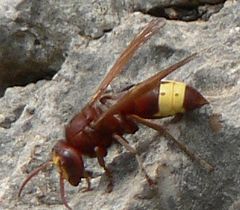- Oriental hornet
-
Oriental hornet 
Scientific classification Kingdom: Animalia Phylum: Arthropoda Class: Insecta Order: Hymenoptera Family: Vespidae Genus: Vespa Species: V. orientalis Binomial name Vespa orientalis
Linnaeus, 1771The Oriental hornet Vespa orientalis, is a hornet which looks very similar to the European hornet. It should not be confused with the Asian giant hornet (Vespa mandarinia).
It is commonly found in the Mediterranean area, but can also be found in Madagascar and India. [1] However, due to human introduction, its habitat is beginning to spread to South America up to Mexico. [2]
The female queen measures 25 to 35 mm long; males and workers are smaller.
In males, the antennae have 13 segments, while females always have 12.
In 2010 a team of researchers from Israeli and British universities discovered that the yellow stripe in the hornet's abdomen is capable of harvesting the sun's light and converting it into energy. In fact, the main metabolic activity occurs in that yellow pigment layer (i.e. the sun may be its main energy source). The process is made possible by a pigment called xanthopterin. This might explain why the insects are more active during intense sunlight, unlike most hornets.[3]
References
- ^ Buxton, P. A. (July 1920). "CARRIAGE OF COLIFORM BACILLI BY THE ORIENTAL HORNET". The Journal of Hygiene (Cambridge University Press) 19: 68–71. JSTOR 3859114. http://www.ncbi.nlm.nih.gov/pmc/articles/PMC2206882/pdf/jhyg00387-0075.pdf. Retrieved 4 October 2011.
- ^ Dvorak, Libor (June 2006). "Oriental Hornet Vespa orientalis Linnaeus, 1771 found in Mexico". Entomological Problems 36: 80. http://www.npsumava.cz/storage/vyzkum/Mexicoorientalis.pdf. Retrieved 4 October 2011.
- ^ Walker, Matt (6 December 2010). "Oriental hornets powered by 'solar energy'". BBC Earth News. http://news.bbc.co.uk/earth/hi/earth_news/newsid_9254000/9254445.stm. Retrieved 9 December 2010.
External links

This Vespidae-related article is a stub. You can help Wikipedia by expanding it.
